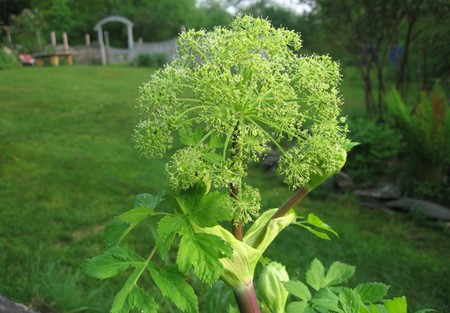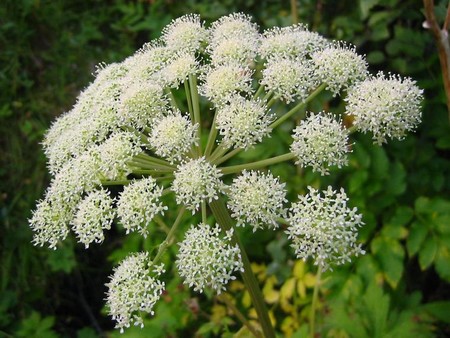Angelica is a stately plant in a woodland garden. It has a beguiling aroma, and its essential oil is used in aromatherapy and perfumes. Its foliage is scented when dried, its seeds can be used as a fixative for potpourris, and the tiny flowers also have a sweet fragrance. It was beloved by medieval herbalists, and John Parkinson in his book Paradisi in Sole Paradisus Terrestris (1629) placed it above all medicinal plants. It was called ‘herba angelica — the herb of the angels.
Most people knowingly encounter angelica only as green pieces of candied stem on cake decorations. However, it is also used to flavour Benedicrine liqueur and gin.
Angelica root has been approved by Commission E for the treatment of digestive problems and loss of appetite. It can be taken in the form of infusions of the dried roots.
However, the American Pharmaceutical Association state that ingesting angelica root carries a health risk.
Unfortunately, two of the compounds in angelicas root oil (xanthotoxin and bergaptene) are furocoumarins. These are phototoxic — that is, they sensitize the skin to light — so you should avoid ultraviolet sun beds or extended sunbathing if using angelica root. Dried roots have less of this effect and so are safer than fresh ones. In animal studies it was found that the furocoumarins could cause cancer. Avoid using angelica preparations during pregnancy and if you are diabetic.
Avoid gathering angelica in the wild. It can easily be mistaken for similar-looking but poisonous plants, including the spotted water hemlock (Cicuta maculata)
Other species
Great angelica, also known as masterwort (Angelica atropurpurea), grows wild in much of eastern North America. It looks similar but has purple stems and grows in wet places. It has been used in similar ways to the garden angelica, particularly as a leaf tea for indigestion and colds. It carries the same cautions.
In Europe wild angelica (A. sylvestris), a striking plant with purple-flushed stems, also grows in freshwater marshes and wet woodlands. A yellow dye can be extracted from it.
Categories
Advertisements
Recent Articles
 How to Understand Bed Sizes – A Small Guide
How to Understand Bed Sizes – A Small Guide How to Select Some Must Have Kitchen Accessories
How to Select Some Must Have Kitchen Accessories Best Way to Change a Car Tire
Best Way to Change a Car Tire Best Way to Write an Affirmation
Best Way to Write an Affirmation Best Way to Take Charge of Your Financial Life
Best Way to Take Charge of Your Financial Life Best Way to Survive a Party When You Don’t Know Anyone
Best Way to Survive a Party When You Don’t Know Anyone Best Way to Stop Self Sabotaging Yourself
Best Way to Stop Self Sabotaging Yourself Best Way to Start Journal Writing
Best Way to Start Journal Writing Best Way to Speak with a Powerful Voice
Best Way to Speak with a Powerful Voice Best Way to Simplify Your Life
Best Way to Simplify Your Life Best Way to Respond to a Put-Down
Best Way to Respond to a Put-Down Best Way to Reduce Acne Breakouts
Best Way to Reduce Acne Breakouts Best Way to Recover from Dining Disasters
Best Way to Recover from Dining Disasters Best Way to Quit Your Job Gracefully
Best Way to Quit Your Job Gracefully Best Way to Make Your Own Website
Best Way to Make Your Own Website



Leave a Reply